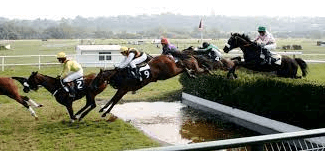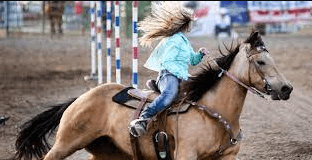What Is The Origin Of The Steeplechase?

The steeplechase, a thrilling equestrian sport that combines speed, endurance, and jumping over obstacles, has a rich history that dates back centuries.
Its origins can be traced to Ireland in the 18th century, where it was initially known as a cross-country race. The sport’s name itself is derived from its early days when riders raced from one church steeple to another, navigating through fields, hedges, and streams along the way.
As the popularity of the steeplechase grew in Ireland, it eventually made its way across the Irish Sea to England. It was during this time that the sport underwent significant developments and formalization. British aristocrats embraced the excitement of steeplechasing and began organizing races with set distances and standardized rules. These events drew large crowds who eagerly cheered on their favorite competitors.
Today, the steeplechase has evolved into an internationally recognized event that takes place in various countries around the world. While it remains deeply rooted in its traditional Irish and English heritage, modern-day steeplechasing has also incorporated elements of showjumping and cross-country riding techniques. With its combination of athleticism and daring feats of horsemanship, the steeplechase continues to captivate audiences worldwide who are drawn to its exhilarating displays of freedom and skill on horseback.
The Origins of the Steeplechase in Ireland
The origins of the steeplechase can be traced back to Ireland, where horse races were held across the countryside, with participants navigating through fields and over obstacles such as stone walls and hedges.
This form of racing emerged during the 18th century and quickly gained popularity in Ireland due to its thrilling nature and challenging course.
The term ‘steeplechase’ originated from the practice of racing from one church steeple to another, which often involved galloping through open terrain and jumping over various obstacles along the way.
Initially, these races were informal events organized by local communities, but they soon evolved into more structured competitions with specific rules and regulations.
Over time, steeplechase spread beyond Ireland’s borders, gaining international recognition as a competitive sport that combines athleticism with horsemanship.
Today, the steeplechase continues to captivate audiences worldwide with its rich history and tradition rooted in Ireland’s rural landscape.
The Spread of the Steeplechase to England
The spread of the steeplechase to England can be traced back to the first recorded steeplechase in 1792.
This event, held in County Cork, Ireland, marked the beginning of a new era in horse racing.
As the popularity of steeplechasing grew, specialized racecourses were developed to accommodate the unique challenges posed by this type of race.
In addition, official rules and regulations were established to ensure fair competition and maintain the integrity of the sport.
These developments played a crucial role in solidifying the steeplechase as a prominent form of horse racing in both Ireland and England.
The First Recorded Steeplechase in 1792
In 1792, an intriguing event unfolded that marked the beginning of the recorded history of steeplechase. It was during this year that the first steeplechase winner emerged, forever leaving its mark on horse racing.
This historic event had a significant impact on the sport, introducing a new and exciting form of competition that captivated audiences around the world. The emergence of steeplechase as a popular equestrian pursuit brought about several notable developments in horse racing.
Firstly, it introduced a thrilling element to the sport by incorporating obstacles such as fences and ditches into races, challenging both horses and riders to display their agility and skill.
Secondly, the introduction of steeplechase helped diversify horse racing events, providing spectators with a fresh alternative to traditional flat races. This expansion of options not only created more opportunities for owners and trainers but also increased overall interest in horse racing as a whole.
Lastly, steeplechase played a crucial role in shaping modern-day jump racing disciplines, serving as a foundation for various forms such as hurdle races and national hunt competitions.
The first recorded steeplechase in 1792 thus set off a chain reaction that revolutionized horse racing while captivating audiences with its exhilarating displays of horsemanship and athleticism.
Development of Specialized Racecourses
Specialized racecourses were developed to accommodate the unique challenges and demands of steeplechase competitions. With the evolution of obstacles in the sport, such as ditches, banks, and water jumps, it became necessary to create racecourses that could provide suitable terrain for these obstacles.
These specialized courses allowed for a more thrilling and visually appealing experience for both spectators and participants alike. Additionally, the development of specialized racecourses had a significant impact on horse breeding. As steeplechase races became more popular, breeders began to focus on producing horses with the athleticism and endurance required to navigate these challenging courses.
This led to the development of specific lines of thoroughbreds that excelled in steeplechase competitions. Overall, the creation of specialized racecourses not only enhanced the excitement and allure of steeplechase events but also played a crucial role in shaping horse breeding practices within this sport.
Establishment of Official Rules and Regulations
Establishment of official rules and regulations in the sport brought a sense of structure and fairness, ensuring that all participants adhered to a standardized set of guidelines. This development was crucial in the evolution of steeplechase as it provided a framework for organizing races and maintaining uniformity across different events.
The establishment of official rules allowed for consistency in race distances, hurdle heights, and other technical aspects, which contributed to the development of specialized racecourses specifically designed for steeplechase competitions. These rules also addressed safety concerns by outlining requirements for horse and jockey equipment, as well as guidelines for course design and obstacle construction.
Moreover, the implementation of official regulations enhanced the credibility and professionalism of steeplechase races, attracting more participants and spectators alike.
Overall, the establishment of official rules and regulations played a significant role in shaping the modern steeplechase landscape by providing a solid foundation for its growth and development on specialized racecourses.
The Modern-day Steeplechase
The evolution of the steeplechase in modern times reflects a rich history and enduring appeal rooted in its unique combination of athleticism, strategy, and tradition.
The development of obstacles and the evolution of the race format have played significant roles in shaping the sport into what it is today.
Over time, steeplechase courses have become more diverse and challenging, with a variety of obstacles including water jumps, hedges, ditches, and fences. These obstacles test not only the speed and endurance of both horse and rider but also their ability to navigate complex terrain.
The race format has also evolved to include different distances and variations such as handicap races or races divided into divisions based on horse ratings. This adds an element of strategy as jockeys must carefully consider factors such as pace, positioning, and timing their challenges over these various obstacles.
Despite these advancements in technology and changes in regulations governing safety standards for both horses and riders, the steeplechase has maintained its timeless appeal by preserving traditions such as dress codes for jockeys and maintaining an atmosphere that celebrates equestrian excellence.
Ultimately, the modern-day steeplechase continues to captivate audiences worldwide with its thrilling displays of skill, courage, and determination while honoring its roots in a long-standing sporting heritage.
Frequently Asked Questions
What is the length of a steeplechase race?
The length of a steeplechase race varies depending on the specific event, but it typically ranges from 2 miles to 4.5 miles. The distance and strategy of the race require athletes to navigate obstacles such as water jumps and hurdles while maintaining a steady pace.
How high are the obstacles typically found in a steeplechase?
The obstacles typically found in a steeplechase are approximately 3.9 feet high. Competitors must employ various training techniques to develop the necessary skills and strength to successfully navigate these challenging barriers during the race.
Are there different types of steeplechase races?
Different types of steeplechase races exist, including hurdle races and timber races. Jockeys play a vital role in these races, as their skill and strategy greatly impact the outcome. Their ability to navigate obstacles efficiently is crucial for success.
What is the attire worn by jockeys in a steeplechase race?
Jockeys in steeplechase races wear specialized attire that prioritizes safety. They typically wear helmets, body protectors, and goggles to safeguard themselves from potential falls or injuries. These safety precautions ensure the well-being of both jockeys and horses during the race.
Read also: What Is The Judging Criteria In Western Pleasure?
How is the winner of a steeplechase race determined?
The winner of a steeplechase race is determined by a scoring system that takes into account factors such as finishing position, time, and penalties incurred. This objective method ensures fairness and accuracy in determining the champion.
Conclusion
The steeplechase, a thrilling horse racing event that involves jumping over obstacles, has its origins in Ireland.
It started as a competition between two horsemen who raced from one church steeple to another, across the countryside. This challenging race captured the imagination of spectators and soon became a popular sport.
The steeplechase then made its way to England in the early 19th century. The Duke of Beaufort is credited with introducing this exhilarating sport to England when he organized the first recorded steeplechase at his estate in 1830. From there, it spread rapidly across the country and gained recognition as an official horse racing discipline.
Today, the steeplechase continues to captivate audiences around the world with its combination of speed, skill, and daring jumps. One can imagine being amidst the cheering crowd on a sunny afternoon at Aintree Racecourse in Liverpool for the famous Grand National Steeplechase. As horses thunder past, their powerful strides carry them over towering fences while jockeys desperately hold onto their reins. The atmosphere is electric as spectators hold their breaths before erupting into cheers when a horse successfully clears each obstacle.
In conclusion, the steeplechase originated in Ireland before spreading to England and evolving into the modern-day sport we know today. Its rich history and thrilling nature make it a favorite among equestrian enthusiasts worldwide. Whether watching or participating, experiencing the heart-pounding action of a steeplechase is an unforgettable experience that showcases both equine athleticism and human determination.





